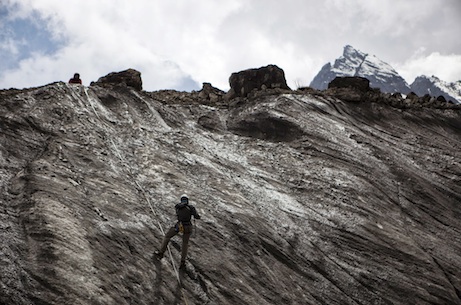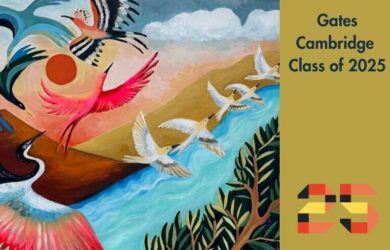
Evan Miles is studying the melt rate of glaciers in the Himalayas.
Evan Miles [2012] is wearing a short-sleeved shirt and sandals. It is mid-winter in the UK, but Evan is used to much colder weather. In the last 18 months since he started his PhD in Polar Studies, he has spent only around eight months in Cambridge. Most of the rest of his time has been spent in the Himalayas of Nepal, studying supraglacial lakes.
The tongues of Himalayan glaciers are covered in rubble. The layer of rock on top of the ice changes the melting process and how water flows across the glacier. Evan is measuring the melt rate of the layer under the rubble as the ice thins and how this is routed across the glacier. “The meltwater collects in depressions on the surface of the glacier and forms lakes,” he says. “The rubble is like a blanket and keeps the glacier cold. When the water piles on top and forms lakes it can increase the speed of energy transfer and enhance the melt locally. After the lake drains you end up with a scar which looks like a cliff of ice, without the blanket of rock to insulate it. These exposed cliffs melt very rapidly, up to tens of metres of ice over a year.”
Evan, who is working with researchers at ETH Zurich, the University of Utrecht and ICIMOD in Kathmandu, says it is estimated that a disproportionate amount [a colleague’s paper is about to be released on this, I shouldnt scoop it!] of the tongue’s meltwater is produced due to these exposed ice cliffs and lakes.
Prior to his PhD research, Evan had taken up a one-year research assistant post at the University of British Columbia where he was working with renowned glaciologist Professor Garry Clarke on modelling glaciers in western Canada and assisted in the development of the Randolph Glacier Inventory. The mapping has provided vital information for the Intergovernmental Panel on Climate Change’s 5th Assessment Report. “You cannot run forward predictions until you know what the current state is,” says Evan.
Evan’s work is now online and is accessed by many academics. He was also involved in a project which aimed to model every glacier in the entire globe – that is, 200,000 distinct bodies of ice.
Background
Evan became involved in glaciology after starting his academic career in engineering.
Born in Portland, Oregon, his father is a mechanical engineer and this may have influenced his choice to do engineering at Oregon State University. However, he also grew up in an outdoors environment and enjoyed winter sports.
Evan’s mother, a self-employed seamstress who teaches sewing, is a keen gardener and Evan would spend a lot of time playing in the garden as a child. He became keen on backpacking and rock climbing and winter sports were always strong favourite – he still does snowboarding, ski touring, alpine skiing and ice climbing whenever possible.
At school he was very well behaved and a bit of a book worm. His strongest subjects at high school were maths, physics, chemistry and Spanish. He took extra computer programming classes and was very interested in data analysis.
Evan found his engineering course fairly easy. Having grown up with a father who was an engineer and was very into British classic cars, he was very familiar with mechanical things. He did two six-month internship programmes during the course, one as an operations manager at technology company Intel in Portland. He worked the night shift and managed a team of 10 technicians at first, eventually managing product efficiency for the entire night shift, including $4bn of equipment and products. His second internship was at a steel manufacturing company, developing a street car for Portland’s public transport system. He says both jobs were good ones, but they did not excite him.
He did a study abroad for several months in Mexico, improving his Spanish and when he returned he looked for something with a more international component. He found this in Engineers Without Borders where he was the fifth member to join the Oregon State University chapter. Over the next few years, the chapter became very active and Evan was Vice President for two years. He did four or five trips to Central America for water projects and says that work showed him that his heart really lay in international work which benefited local communities and involved rugged fieldwork.
For his masters, also at Oregon State University, he chose to do water resources science, focusing mainly on groundwater hydrology in a special geological area near the city using a large data set. This allowed him to build his Geographic Information Systems skills and remote sensing abilities.
After his masters he continued working at Oregon State as a research assistant doing long term hydrological research. He had two part-time jobs. One was in the Oregon State University library, working for the Institute for Natural Resources to manage natural resources spatial data using GIS and web programming. The other was a numerical analysis project of long-term climate change in 40 different sites in the US, Canada and Mexico over a period of 80 years.
After this he left for Canada, but before doing so he applied to the University of Cambridge. Following his PhD, Evan hopes in the future to either continue his work in Nepal or work on Patagonian glaciers which he says have been poorly studied.












